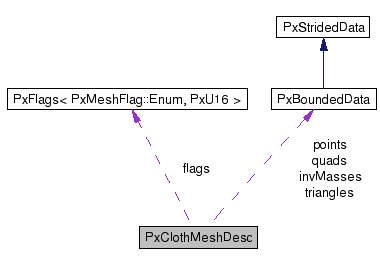PxClothMeshDesc Class Reference
[Cooking]
Descriptor class for a cloth mesh.
More...
#include <PxClothMeshDesc.h>

Public Member Functions | |
| PX_INLINE | PxClothMeshDesc () |
| constructor sets to default. | |
| PX_INLINE void | setToDefault () |
| (re)sets the structure to the default. | |
| PX_INLINE bool | isValid () const |
| Returns true if the descriptor is valid. | |
Public Attributes | |
| PxBoundedData | points |
| Pointer to first vertex point. | |
| PxBoundedData | invMasses |
| Determines whether particle is simulated or static. A positive value denotes that the particle is being simulated, zero denotes a static particle. This data is used to generate tether and zero stretch constraints. If invMasses.data is null, all particles are assumed to be simulated and no tether and zero stretch constraints are being generated. | |
| PxBoundedData | triangles |
| Pointer to the first triangle. | |
| PxBoundedData | quads |
| Pointer to the first quad. | |
| PxMeshFlags | flags |
| Flags bits, combined from values of the enum PxMeshFlag. | |
Detailed Description
Descriptor class for a cloth mesh.
- Deprecated:
- The PhysX cloth feature has been deprecated in PhysX version 3.4.1
- See also:
- PxCooking.cookClothMesh()
Member Data Documentation
Determines whether particle is simulated or static. A positive value denotes that the particle is being simulated, zero denotes a static particle. This data is used to generate tether and zero stretch constraints. If invMasses.data is null, all particles are assumed to be simulated and no tether and zero stretch constraints are being generated.
Referenced by isValid().
Pointer to the first quad.
These are quadruples of 0 based indices: vert0 vert1 vert2 vert3 vert0 vert1 vert2 vert3 vert0 vert1 vert2 vert3 ...
where vert* is either a 32 or 16 bit unsigned integer. There are a total of 4*count indices. The stride determines the byte offset to the next index quadruple.
This is declared as a void pointer because it is actually either an PxU16 or a PxU32 pointer.
Referenced by isValid().
Pointer to the first triangle.
These are triplets of 0 based indices: vert0 vert1 vert2 vert0 vert1 vert2 vert0 vert1 vert2 ...
where vert* is either a 32 or 16 bit unsigned integer. There are a total of 3*count indices. The stride determines the byte offset to the next index triple.
This is declared as a void pointer because it is actually either an PxU16 or a PxU32 pointer.
Referenced by isValid().
The documentation for this class was generated from the following file:
Copyright © 2008-2017 NVIDIA Corporation, 2701 San Tomas Expressway, Santa Clara, CA 95050 U.S.A. All rights reserved. www.nvidia.com
